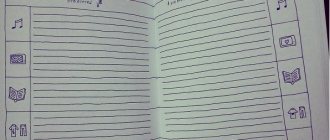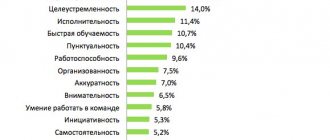Sample of psychological and pedagogical characteristics of children with mental retardation
A sample of psychological and pedagogical characteristics of a student with mental retardation.
Name of the organization
Characteristic
student __ class name of organization
Full name
________ year of birth, living at the address:
FI entered this school in __ grade _______ based on the conclusion of the PMPK from _________________. The child lives and is raised in a (full, single-parent, large, low-income) family. Education in a family is carried out by (mother, father, grandmother, etc.), who have uniform (inconsistent) requirements for the child and the organization of his free time. The FI obeys (does not obey) the demands of the parents, observes (does not comply with) the daily routine, is friendly (aggressive) in communication, and performs (does not have) responsibilities around the house. The class teacher (teacher) maintains contact with parents (during visits to the family, during school events, by telephone).
The child is physically sufficiently (insufficiently) developed. Coordination of movements (appropriate for age, underdeveloped, impaired, grossly impaired).
FI is trained according to an adapted general education program of basic general education for students with disabilities. (Training takes place according to an individual program). Masters the ___ class curriculum in all subjects.
Reads (letter by letter, slowly by syllables, fluently by syllables, in whole words) the meaning of what was read (understands, understands with difficulty, does not understand) answers questions about what was read (does not answer) answers (with errors, monosyllabically, independently). Retells the content of what was read (based on a picture, based on questions, independently with errors, independently and correctly). Can (not able to) memorize (short poems, long poems, prose).
Copies from printed and (or) handwritten text (by letter, by syllable, by whole words). Under dictation (does not write) writes, (makes a large number of mistakes, makes a minimal number of mistakes, no mistakes). Grammar tasks (does not complete) completes (with the help of the teacher, independently with errors, independently correctly). Handwriting is legible (illegible).
Counting and computing skills are sufficiently (insufficiently) developed. Mastered forward (and backward) counting within ___ (mechanically, consciously). Can solve examples (addition within ___, subtraction within ___, multiplication within ___, division within ___). Can use (knows) the multiplication table. The meaning of the task (understands, needs additional clarification, does not understand). Solve problems (independently, needs help from teacher). Geometric material assimilates (not assimilates).
FI has attention (active, sustained, voluntary, superficial, unstable, distractible, involuntary). The most effective means of attracting attention are (visual material, changing the volume, pitch of the voice.
Perception and sensations are developed (sufficiently, insufficiently, in accordance with age). Tempo (slow, medium, high), completeness and correctness of perception (fragmentary, holistic, with additions), recognition of objects and phenomena (difficult, adequate). Temporary representations (not formed, formed), sequence of events (understands, confuses, does not retain). Basic geometric shapes (recognizes, names, confuses, does not know). Perception of size (formed, not formed). Orientation in space: right-left (confuses, knows, does not understand), top-bottom (confuses, knows, does not understand), close-far (confuses, knows, does not understand). Orientation on a sheet of paper (formed, unformed)
Memory is developed (sufficiently, insufficiently, in accordance with age). The nature of memorizing information (voluntary, involuntary, productive, unproductive). The nature of the reproduction (accurate, inaccurate, with errors, with additions, distorted, etc.). Predominant (mechanical, visual, auditory, motor) memory. Verbal-logical, indirect, associative memory (not developed, primitive, partially developed). Means used to develop memory and better memorization of material: (use of emotional coloring of the material, clarity, didactic games, structuring of material, motor activity, etc.).
Thinking (passive, stereotypical, stiff, concrete, active), (non-verbal, visual-effective, with elements of visual-figurative, visual-figurative, with elements of verbal-logical, verbal-logical). Operations of comparison, generalization, exclusion of unnecessary things, classification, establishment of cause-and-effect relationships (not developed, not accessible, insufficiently developed, formed below the age norm). When mastering concepts (can, can’t), identify essential features and give definitions.
The child (understands, does not understand) the spoken speech, (follows, does not follow) simple instructions. Vocabulary (age-appropriate, limited, severely limited). The grammatical structure of speech (appropriate for age, impaired, not impaired). Tempo, rhythm of speech (disturbed, not disturbed): (accelerated, slowed down, with hesitations). Expressiveness of speech (developed, not developed): (intonation coloring (uses, does not use). The child’s speech (active, adequate, needs stimulation, spontaneous and disinhibited). Monologue speech (formed, not formed). Dialogical speech of the child (developed, not developed). not developed): (can answer questions, ask them, follow the sequence of statements, retain the content of the conversation). Speech (not impaired, impaired). FI (needs, does not need speech therapy assistance).
FI relates to work and study (positively, indifferently, negatively). In relationships with teachers and educators (friendly, respectful, interested, intrusive, indifferent, aggressive, rude, etc.). Complies (does not comply, resists) regime and disciplinary requirements. Behaves during lessons (interested, active, passive, refuses to do activities). The child has (or does not have) the skills to behave in a society of peers and adults. The reasons for violation of discipline are (attracting attention to oneself, revenge, power, avoiding failures). Actions and deeds are meaningful (chaotic and meaningless). When difficulties arise (makes efforts to overcome them, becomes aggressive, whiny, asks for help from an adult, accepts help, refuses activities). FI has deficiencies in the development of the will: (easily suggestible, driven, pliable, self-willed, impulsive, absent-minded, avoiding difficulties, etc.). Cultural behavior skills are formed (partially formed, not formed): the child is polite (rude), sensitive (indifferent), responsive (self-loving), neat (sloppy). Shows (does not show) interest in (extracurricular, work, club work, sports and games). Interests are stable (unstable).
The character of the FI is different (kindness, sincerity, hard work, restraint, modesty, honesty, self-criticism, self-confidence, collectivism; selfishness, isolation, secrecy, negativism, inflated claims, laziness, deceit, capriciousness, hot temper, aggressiveness, pugnacity, etc.) . The child’s mood (sustainably positive, depressed, unstable). FI is prone (not prone) to affective reactions, long-term (quickly passing) experiences. Self-esteem (low, adequate, high). In a children's team he has the status of (leader, preferred, accepted, outcast). Enjoys (does not enjoy) the respect of peers.
FI does not (has) any bad habits. He is not registered with law enforcement agencies, social services, or prevention system agencies. Sanitary and hygienic skills are formed (partially formed, not formed).
In further educational, correctional and developmental work, attention should be paid to the development (cognitive sphere, emotional-volitional sphere, motor sphere, personal sphere).
date
Classroom teacher:
Director:
Causes of the disease
- damage to the fetus in the mother's womb by neurotoxic factors of an infectious, chemical, physical nature - syphilis, cytomegalovirus, ionizing radiation and others;
- the birth of a baby before a certain time is a major prematurity;
- disruptions during the birth process, as a result of which the baby could receive a birth injury or temporary asphyxia was observed;
- receiving serious head injuries in early childhood;
- brain hypoxia;
- infectious diseases that resulted in damage to the child’s central nervous system;
- living in dysfunctional families and, as a consequence, pedagogical neglect;
- manifestation of dementia of unknown etiology.
Is oligophrenia curable?
Treatment and correction of this disease is not an easy task; it will require a lot of effort, time, and patience. In addition, different levels of mental retardation and the age of the patient require their own methodology. However, if the tactics are chosen correctly, a positive result becomes noticeable within a couple of months.
Unfortunately, complete relief from intellectual disability is impossible. The thing is that certain parts of the brain are damaged. The nervous system to which it belongs is formed during the period of intrauterine development of the fetus. After the birth of a child, its cells almost do not divide and are not able to regenerate. That is, the damaged neurons will not recover and mental retardation remains with the person for the rest of his life, although without progressing.
But, as already mentioned, children with a mild degree of the disease respond well to correction, receive self-care skills, education, and can work quite normally, performing simple tasks.
Syndromes combined with different degrees of MR
Down syndrome is the most common genetic cause of intellectual disability. It is caused by a chromosomal abnormality - if normally there are 46 of them, then in this case there is an unpaired 47th chromosome. People with this syndrome can be identified by an abnormally short skull, flat face, short arms and legs, short stature, and small mouth. They process the information received poorly and remember it, they lack the concept of time and space, and their speech is poor. Moreover, such individuals adapt well to society.
Martin-Bell syndrome (fragile X chromosome). The second most common genetic cause of mental retardation. It is recognized by the following external features: increased mobility of joints, an elongated face, an enlarged chin, a high forehead, large, protruding ears. They start talking late, but poorly, or don’t speak at all. They are very shy, hyperactive, inattentive, constantly moving their hands and biting them. Men have more cognitive impairment in this category than women.
Williams syndrome (“elf face”). It occurs as a result of hereditary chromosomal rearrangement, the loss of genes in one of them. The patients have a very interesting appearance: the face is narrow and long, blue eyes, flat nose, large lips. Usually suffer from cardiovascular diseases. Rich vocabulary, good memory, excellent musical abilities, and social interaction skills. But there are problems with psychomotor skills.
Angelman syndrome (happy doll or Parsley). Caused by a change in chromosome 15. Very light eyes with characteristic spots on the iris and hair, the head is small, the chin is pushed forward, the mouth is large, the teeth are sparse and long. Severe delay in psychomotor development, significant impairment of speech and movement (poor balance, walks on stiff legs). He often smiles and even laughs for no reason.
Prader-Willi syndrome . It is characterized by the absence of a paternal copy of chromosome 15 and a number of other disorders. He is short in stature, has small arms and legs, suffers from compulsive overeating, and, as a result, obesity. Problems with short-term memory, speech, information processing.
Lejeune's syndrome (cry of the cat or 5p syndrome). A very rare and serious disease caused by the absence of the short arm of chromosome 5. The head is small, the face is round, the lower jaw is underdeveloped and the bridge of the nose is wide, so the eyes are located far from each other. The feet are turned out, the hands are small. The larynx is underdeveloped, there are vision problems, in particular, strabismus. She often cries and makes a sound similar to a kitten meowing. Motor development is delayed, and the ability to pay attention is limited.
In addition to the syndromes mentioned, intellectual disability can coexist with cerebral palsy, deafness and blindness, autistic disorders, epilepsy and other somatic and mental illnesses.










